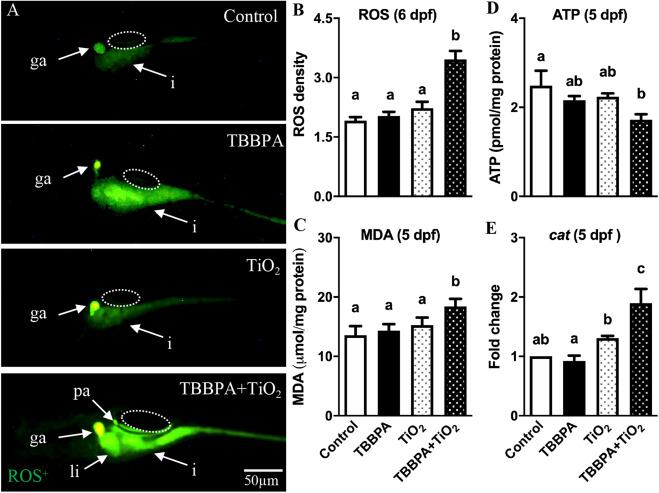Fig. 6 Effect of TBBPA and TiO2 NP on oxidative stress. Zebrafish embryos were exposed to 0.1% DMSO control, 2 μM TBBPA, 0.1 mg/L TiO2 NP and TBPPA/TiO2 NP mixture from 8 to 120 hpf. Larvae harvested immediately after exposure at 5 dpf were used for MDA, ATP, and cat analysis and larvae 6 dpf were used for ROS in vivo staining. (A) Representative images showing reactive oxygen species (ROS) staining with the cell membrane-permeable ROS marker 2′,7′-di-chlorodihydrofluorescein diacetate (H2DCF-DA). (B) Quantification of ROS staining density (n = 20). (C) Lipid peroxidation expressed as malondialdehyde (MDA) by using whole larval homogenate from pooled larvae at 5 dpf (n = 6 replicates with each replicate pooled from 20 larvae). (D) Adenosine triphosphate (ATP) measured using whole larval homogenate from pooled larvae at 5dpf (n = 6 replicates with each replicate pooled from 20 larvae). (E) Gene expression fold changes of antioxidant enzyme catalase (cat) at 5 dpf (n = 3, each replicate consists pooled RNA sample from 20 larvae). The dashed elliptical area marked the swim bladder region. ga: gallbladder; pa: pancreas; i: intestine; li: liver. Values plotted are mean ± SEM and bars sharing the same letter indicate no significant difference at the level of P < 0.05 using one-way analysis of variance (ANOVA) followed by Tukey’s multiple comparison test.
Image
Figure Caption
Acknowledgments
This image is the copyrighted work of the attributed author or publisher, and
ZFIN has permission only to display this image to its users.
Additional permissions should be obtained from the applicable author or publisher of the image.
Full text @ Ecotoxicol. Environ. Saf.

